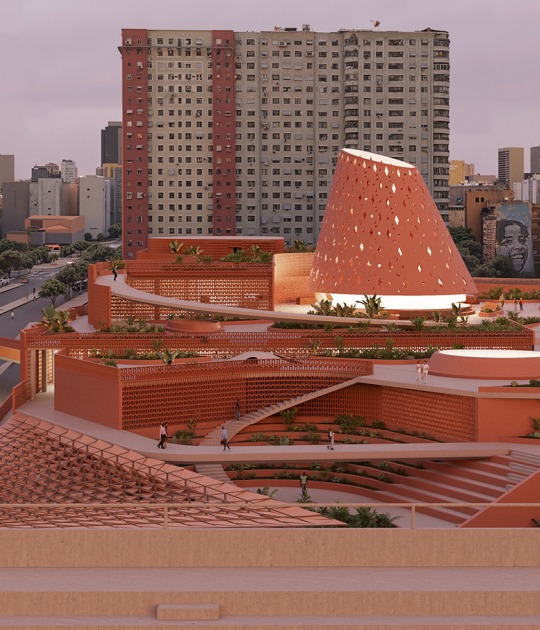Targeting LEED Platinum certification, Masarycka incorporates external fins on the façade to contribute to solar shading in the summer and transform the project's horizontal composition to the verticality of its western façade facing the spires of the Old Town. It contains office and retail uses in seven stories within its eastern section and nine stories at its western end.
A cascade of terraces divides the development’s two wings, while additional terracing on the eastern facade gives every office floor direct access to open spaces. Masarycka's construction and procurement have prioritized local suppliers and materials with high recycled content.

Masaryčka by Zaha Hadid Architects. Photograph by BoysPlayNice.
Project description by Zaha Hadid Architects
With its facades now completed, the Masaryčka building in Prague is defined by circulation routes which will provide access to new civic spaces for the city. Accommodating the continued growth of the city’s corporate sector with office spaces designed to meet 21st-century working patterns, the 28,000 sq. m Masaryčka office and retail development incorporate seven stories within its eastern section and nine stories at its western end.
Integrating with Czech Railways’ modernization of the historic Masaryk Railway Station is creating a new public square partially over the railway tracks, Masaryčka’s design will enhance accessibility to the railway platforms below and provide new pedestrian routes between Florenc and Hybernská on either side of the station.
Bordered by Masaryk Station’s railway platforms to the south, Na Florenci Street to the north, and the Wilsonova elevated freeway to the east, Masaryčka has been constructed on a derelict site that has stood abandoned for several decades. To the west, Masaryčka replaces the existing car park on Havlíčkova Boulevard with a new public square with interchanges between the city’s rail, tram, and bus networks; defining a welcoming gateway to the city for suburban rail passengers as well as those using the express rail link that is currently under-construction to Prague’s international airport.

Masaryčka by Zaha Hadid Architects. Photograph by BoysPlayNice.

Masaryčka by Zaha Hadid Architects. Photograph by BoysPlayNice.
Located one kilometer east of the city center’s Staroměstské Square, Masaryčka’s design establishes a dialogue with the architecture and urbanism of Prague’s Old Town – known as ‘the golden city of 100 spires’. External fins within Masaryčka’s façade contribute to solar shading in the summer and transform the project’s horizontal composition to the verticality of its western façade facing the spires of the Old Town.
Targeting LEED Platinum certification, Masaryčka incorporates a double-insulated façade that ensures optimal natural light in all work areas and communal spaces. A cascade of terraces divides the two buildings while similar terracing on the eastern façade gives every office floor direct access to generous outdoor spaces. Communal roof gardens offer panoramic views across the city. Hybrid ventilation is supported by a high-efficiency plant with waste heat recovery systems while the building’s smart management systems continually monitor and adjust environmental controls to reduce energy consumption.

Masaryčka by Zaha Hadid Architects. Photograph by BoysPlayNice.
Planting using local species of plants, shrubs, and trees irrigated by Masaryčka’s rainwater collection system, including the transformation of Na Florenci into a tree-lined avenue, will provide cooling summer shade and natural air purification. Low-flow systems and grey-water recycling will further reduce the center’s water consumption.
Masaryčka’s construction and procurement have prioritized local suppliers and materials with a high recycled content to meet the 2025 targets for embodied & operational carbon established by the RIBA 2030 Climate Challenge.
Due for completion in 2026, Czech Railways’ renovation of Masaryk Railway Station adjacent to Masaryčka retains the existing historic terminus building and includes the construction of the new public square partially over the tracks giving access to individual platforms and a direct transfer to Prague’s metro line B. Transforming the station into a fully accessible, multi-modal transport hub for the city, its modernization program extends the current number of tracks from seven to nine and reconstructs all platforms, overhead line equipment, and power supply.







































